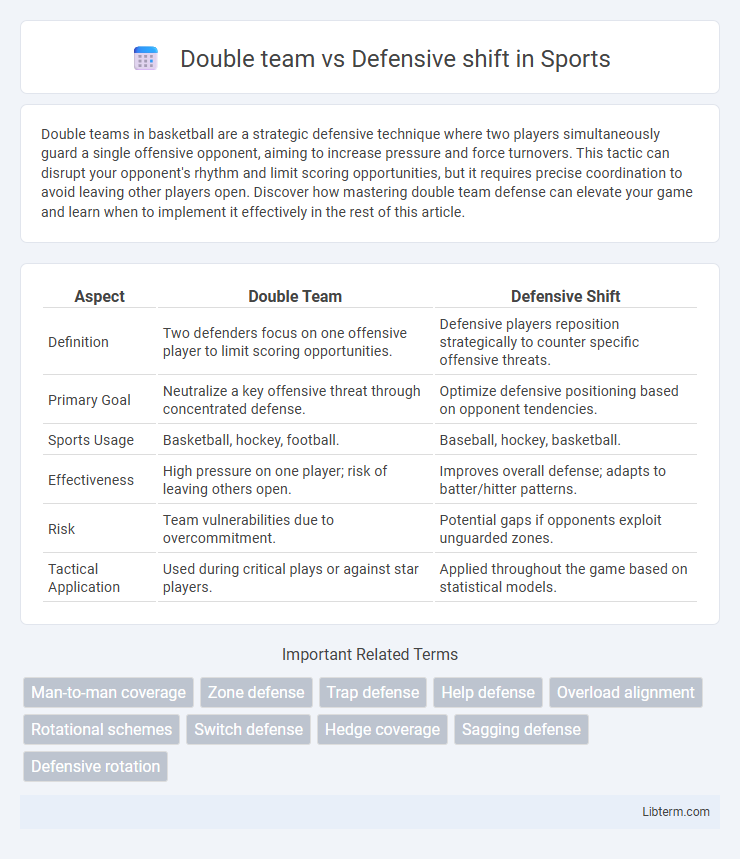Double teams in basketball are a strategic defensive technique where two players simultaneously guard a single offensive opponent, aiming to increase pressure and force turnovers. This tactic can disrupt your opponent's rhythm and limit scoring opportunities, but it requires precise coordination to avoid leaving other players open. Discover how mastering double team defense can elevate your game and learn when to implement it effectively in the rest of this article.
Table of Comparison
| Aspect | Double Team | Defensive Shift |
|---|---|---|
| Definition | Two defenders focus on one offensive player to limit scoring opportunities. | Defensive players reposition strategically to counter specific offensive threats. |
| Primary Goal | Neutralize a key offensive threat through concentrated defense. | Optimize defensive positioning based on opponent tendencies. |
| Sports Usage | Basketball, hockey, football. | Baseball, hockey, basketball. |
| Effectiveness | High pressure on one player; risk of leaving others open. | Improves overall defense; adapts to batter/hitter patterns. |
| Risk | Team vulnerabilities due to overcommitment. | Potential gaps if opponents exploit unguarded zones. |
| Tactical Application | Used during critical plays or against star players. | Applied throughout the game based on statistical models. |
Understanding Double Team and Defensive Shift
Double team and defensive shift are strategic defensive techniques used in basketball to disrupt the offensive players. A double team involves two defenders actively guarding a single offensive player to pressure and potentially force turnovers, while the defensive shift reallocates defenders to cover specific zones or players based on the offensive setup. Understanding the nuances of these tactics helps teams enhance defensive efficiency by maximizing player positioning and minimizing scoring opportunities.
Key Differences Between Double Team and Defensive Shift
Double team involves two defenders converging on a single offensive player to pressure ball control and limit scoring opportunities, creating numerical defensive superiority. Defensive shift repositions multiple defenders simultaneously to counter a team's offensive formation or tendencies, optimizing spatial coverage and disrupting passing lanes. The key difference lies in double team targeting one player directly, while defensive shift adjusts overall team alignment for broader strategic coverage.
Strategic Purpose of Double Team
The strategic purpose of a double team in basketball is to apply intense defensive pressure on a key offensive player, forcing turnovers or rushed decisions that disrupt the opponent's offensive flow. Unlike the broader defensive shift, which realigns positioning to cover space and anticipated plays, a double team concentrates resources on neutralizing a single threat. This tactic often catalyzes scoring opportunities for the double-teaming team by creating mismatches and leaving other opponents open.
Tactical Advantages of Defensive Shift
The Defensive Shift in baseball strategically repositions infielders based on hitter tendencies, significantly reducing the likelihood of base hits to high-probability zones. This tactic enhances force-out opportunities and limits batting averages on balls in play, effectively neutralizing powerful left-handed pull hitters. Compared to the Double Team, the Defensive Shift offers greater flexibility in coverage, optimizing spatial defense and minimizing run expectancy.
Situational Applications in Gameplay
Double team strategies intensify defensive pressure by assigning two defenders to a high-impact offensive player, effectively limiting scoring opportunities during critical moments like pick-and-rolls or isolations. Defensive shift techniques reposition the entire defense based on the offensive formation and ball location, optimizing coverage against perimeter shooters or inside threats during situational plays such as transition defense or late-game possessions. Implementing these tactics dynamically enhances defensive adaptability, disrupts offensive rhythm, and maximizes the team's ability to force turnovers or contested shots in high-stakes gameplay scenarios.
Player Roles in Double Team vs Defensive Shift
In a double team, player roles emphasize aggressive containment and pressure, with two defenders strategically converging on a single offensive player to limit options and force turnovers. Defensive shift reallocates roles fluidly across the field, prioritizing spatial coverage and anticipation by adjusting player positions based on opponent tendencies and ball location. The double team demands tight coordination between two defenders, while the defensive shift relies on collective awareness and adaptive positioning from the entire defensive unit.
Impact on Opposing Offense
Double teams disrupt the opposing offense by forcing defenders to concentrate on a single key player, limiting passing and scoring options. Defensive shifts alter team alignment to exploit opponent tendencies, creating coverage mismatches that reduce offensive efficiency. Both strategies pressure ball handlers and restrict space, slowing down offensive rhythm and increasing turnover potential.
Statistical Outcomes and Effectiveness
Double teams increase pressure on key offensive players, often resulting in turnovers and lower shooting percentages, with NBA teams averaging a 5% higher forced turnover rate during such plays. Defensive shifts, characterized by strategic repositioning based on opponents' tendencies, improve opponent shot selection efficiency, decreasing uncontested shots by approximately 12%. Statistical outcomes reveal double teams yield immediate disruption but risk open shots for others, while defensive shifts enhance long-term defensive consistency and reduce overall opponent scoring efficiency by an estimated 3-4%.
Common Mistakes and How to Avoid Them
Double teaming often leads to defensive breakdowns due to poor communication and leaving open passing lanes, while the defensive shift can cause mismatches if players fail to maintain proper positioning. Common mistakes include neglecting to rotate quickly and losing track of shooters during these tactics. Avoid errors by emphasizing clear communication, consistent practice of rotations, and reinforcing spatial awareness on the court.
Choosing the Right Defensive Strategy
Choosing the right defensive strategy involves evaluating the strengths and tendencies of opposing players to maximize team efficiency. Double team tactics concentrate defensive pressure on a key threat, disrupting their playmaking ability, while defensive shifts optimize positional adjustments to counter specific hitters' tendencies. Teams must analyze situational data and player statistics to decide between aggressive double teaming or systematic defensive shifting for effective run prevention.
Double team Infographic

 libterm.com
libterm.com